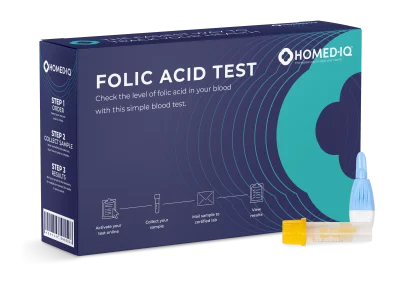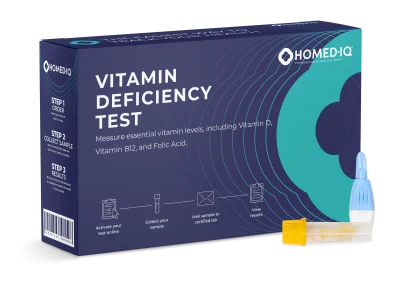Folic acid, also known as Vitamin B9 or B11, is an important part of the Vitamin B complex. Normal folate levels range between 10 and 40 nmol/L; levels below 10 nmol/L indicate a deficiency and can cause anemia. A level above 45 nmol/L may suggest excessive folate intake and can mask symptoms of a Vitamin B12 deficiency.
Together with Vitamin B12, folic acid supports the formation of red blood cells. Therefore, if there is a folic acid deficiency, it is generally recommended to also take B12. In the Western world, it is common for people to have a folic acid deficiency. Are you wondering if this might be the case for you? Homed-IQ offers a folic acid test that allows you to check your folic acid level in the blood from the comfort of your home. All results are evaluated by ISO-certified laboratories, which are also used by medical practices and clinics.
What is folic acid?
Folic acid is one of the B vitamins, more specifically vitamins B9 and B11. It is a vitamin that is usually obtained through food as there is no production of folic acid in the body itself. Folic acid is important for the production of white and red blood cells, nerve cells, and the development of the nervous system of an unborn baby. It also helps your body’s immune system and has a positive effect on your memory, learning performance, and mood. Folic acid leaves your body in small amounts through the urine (Apotheek.nl, 2018).
What is a normal value for folic acid?
The normal folic acid level in the blood ranges between 10 and 40 nanomoles per liter (nmol/L). Levels below 10 nmol/L can indicate a folic acid deficiency, which may lead to anemia or other health problems.
| Status | Value (nmol/L) | Symptoms | Causes |
|---|---|---|---|
| Too low | Below 10 | Fatigue, anemia, dizziness, shortness of breath, memory problems | Poor diet, malabsorption, alcoholism |
| Normal | 10-40 | No symptoms | Sufficient folate intake through diet |
| Too high | Above 45 | Can mask Vitamin B12 deficiency, possible neurological damage | Excessive supplementation (dietary supplements) |
High folic acid level: above 45 nmol/L
A high folic acid level in the blood (above 45 nmol/L) usually results from excessive intake of folic acid supplements. This can mask the symptoms of a Vitamin B12 deficiency and lead to neurological damage. Excessive intake through diet is rare and not harmful.
Low folic acid level: below 10 nmol/L
A low folic acid level (below 10 nmol/L) may indicate a deficiency. This often leads to anemia, fatigue, memory problems, and in pregnant women, an increased risk of neural tube defects in the baby. Possible causes include a poor diet, alcohol abuse, or certain medical conditions.
A low folic acid level in the blood (below 10 nmol/L) often indicates a deficiency. This can lead to anemia, fatigue, and in severe cases, neurological problems. Adequate folic acid is important for the formation of red blood cells and DNA synthesis.
| Folic acid Level (nmol/L) | Interpretation | Explanation |
|---|---|---|
| 6 | Too low | Severe folate deficiency, below 10 nmol/L. |
| 7 | Too low | Possible folate deficiency, below 10 nmol/L. |
| 9 | Too low | Just below the lower limit, indicates deficiency. |
| 11 | Normal, but low | Near the lower limit of the normal range, possible early deficiency. |
| 12 | Normal, but low | Within the normal range, near the lower limit. |
| 13 | Normal | Value within the healthy range (10-40 nmol/L). |
| 18 | Normal | Within normal limits, sufficient folate in the blood. |
| 25 | Normal | Value within the normal range (10-40 nmol/L). |
| 30 | Normal | Value within the healthy range (10-40 nmol/L). |
| 40 | Normal | Still within the healthy range. |
What foods contain folic acid?
There are several foods that contain folic acid:
- Meat products
- Dairy products
- Fortified bread
- Whole-wheat products
- Green vegetables
- Fruit
What does folic acid do?
Folic acid is important for the proper functioning of your body for several reasons. The vitamin is important for:
- The formation of red and white blood cells and oxygen transport throughout the body
- Normal cell division
- Immune system support
- Fetal growth during pregnancy
- Building blocks for digestion
- Protecting the skin
- Healing wounds
Folic Acid During Pregnancy
It is recommended that women who want to have children take folic acid as a supplement before conception to prevent neural tube defects. This also applies to women who have just become pregnant. This is because folic acid is very important in forming the neural tube of a developing baby, and not obtaining enough puts you at higher risk of serious birth defects.. Once you are pregnant, it is advisable to take folic acid daily during the first ten weeks of pregnancy.
How much folic acid do you need per day?
The average daily requirement for folic acid varies per person. The ‘Reference Intake’ (RI), or the average requirement per day, is as follows (Nutrition Centre):
Average requirement per day:
300 micrograms, adults
400 micrograms if you wish to become pregnant, are pregnant or breast-feed
60 micrograms, children from 6 to 11 months
85 micrograms, children aged 1 to 3 years
150 micrograms, children aged 4 to 8 years
225 micrograms, children aged 9 to 13 years
300 micrograms, children aged 14 to 17 years
Are there any diseases that cause folic acid deficiency?
Intestinal diseases are sometimes linked to a folic acid deficiency. An example of this is Crohn’s disease, an intestinal disease in which the body is unable to absorb sufficient folic acid from food (Jeroen Bosch Hospital, 2022).
What health effects can a folic acid deficiency have?
A (serious) deficiency of folic acid in the body can lead to various symptoms:
- Fatigue
- Intestinal problems
- Anemia
- Neural tube birth defects
Why test for folic acid?
Are you curious about your folic acid levels? Perhaps because you want to become pregnant, are pregnant, or suffer from complaints that can be caused by a folic acid deficiency? Then it is useful to test yourself. This is possible with the Homed-IQ’s Vitamin Deficiency Test. This test not only gives you insight into your folic acid, but also measures your vitamin B12 and vitamin D levels.
-

Folic Acid Test
€45,00 -

Vitamin Deficiency Test
€65,00
How often should you test your folic acid level?
There is no recommended frequency when it comes to measuring folic acid levels. It is possible to perform a test at home at any time. If your folic acid value is too low or too high, you can take another test in a few months.
Is Homed-IQ’s folic acid test reliable?
Yes, your test sample – like all of Homed-IQ’s home tests – is processed and analyzed in a certified laboratory. These labs are also used by general practitioners, hospitals and other medical specialists.
Is this folic acid test an alternative to a blood test through my GP?
Yes, a doctor would use the same test to determine whether you have a folic acid deficiency or not. The difference is that you can take the Homed-IQ self-test from the comfort of your own home, anonymously and at a time of your choosing.
How does the Homed-IQ folic acid test process work?
The test process for all Homed-IQ health tests is very simple. First, a blood sample is obtained via a finger prick and deposited into the collection tube. Then, use the supplied transport bag and the return envelope to send your sample to the lab. Your results will be ready within a few days.
What can I do if my folic acid level is too low?
If your folic acid level is too low, it is advisable to take a closer look at your diet. Try to eat a varied and healthy diet every day, including foods that contain folic acid. If you are trying to get pregnant, or are already pregnant, it is advisable to take folic acid pills.






